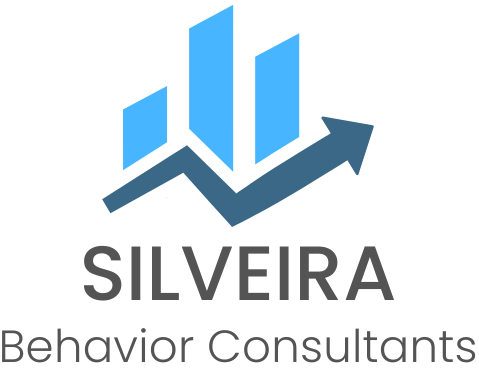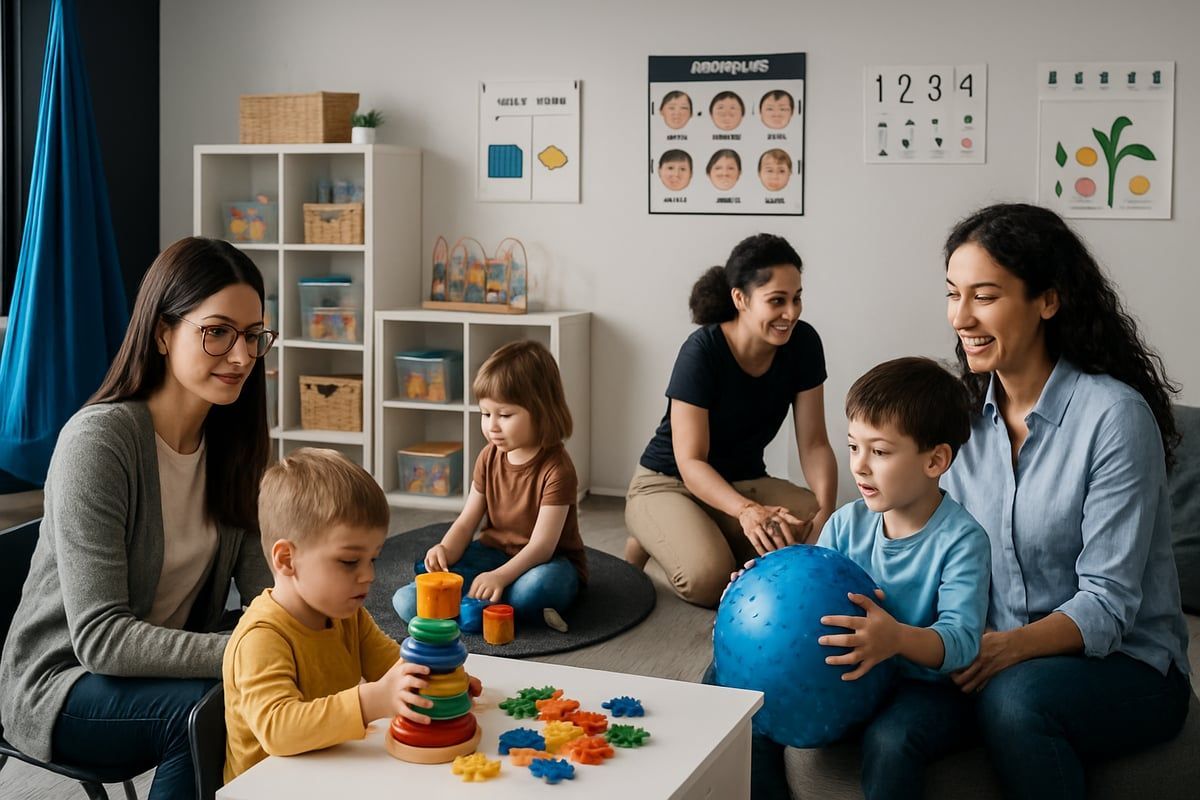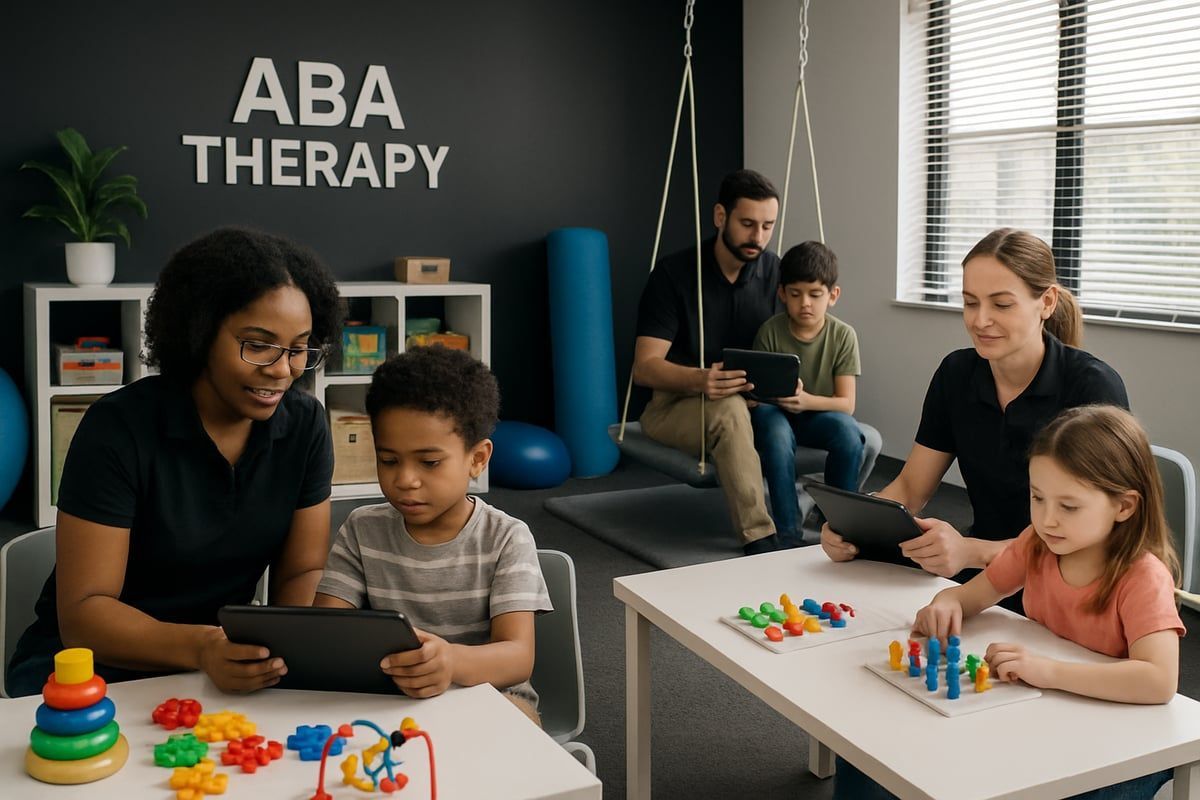Treatment Planning and Goal Setting
Once intake data is collected, the clinic ABA team collaborates with families to set
clear, measurable goals. This partnership ensures priorities align with both clinical expertise and family values. Goals may focus on communication, social skills, self‑care, or academic readiness.
Objectives are broken into manageable steps so progress is easy to track. Regular reviews allow the team to adapt goals as the child grows. In clinic ABA, these collaborative sessions keep families engaged and invested in the journey.
Frequent plan updates ensure therapy remains relevant and effective. Families are encouraged to share observations, making goal‑setting a truly joint effort.
Therapy Implementation: Daily Clinic Activities
A typical day in
clinic‑based ABA therapy is structured yet flexible, balancing evidence‑based techniques with opportunities for play and social learning. Sessions are scheduled according to the child’s needs, with activities rotated to maintain engagement and motivation.
Therapists may blend
Discrete Trial Training (DTT) for structured skill‑building with
Natural Environment Teaching (NET) to encourage learning in everyday contexts. Play‑based activities and peer interaction are also incorporated, ensuring therapy is both effective and enjoyable.
Therapy Implementation: Daily Clinic Activities
Therapists in
clinic‑based ABA therapy use a mix of
Discrete Trial Training (DTT),
Natural Environment Teaching (NET), and
token systems to build skills. Age‑appropriate toys and sensory spaces add variety, keeping sessions engaging.
For example, play‑based learning in clinic ABA might involve practicing
turn‑taking or sharing, helping children build independence, confidence, and social skills. Flexibility is key—activities are continuously adjusted to match each child’s progress, ensuring therapy remains effective and motivating.
Monitoring Progress and Reassessment
Tracking progress is a cornerstone of clinic ABA. Therapists collect data during every session, noting skill gains and any new behavioral challenges. This information is reviewed by the
Board Certified Behavior Analyst (BCBA), who schedules reassessment meetings—often every six months—with families.
These check‑ins allow the clinic ABA team to adjust treatment plans as needed. If a child masters a skill, new targets are set. If challenges arise, strategies are refined to overcome obstacles.
Regular monitoring ensures therapy stays on track, and families remain informed about their child’s growth.
Parent and Caregiver Collaboration
Lasting success in clinic ABA relies on strong partnerships with families. Monthly parent training sessions teach
practical ABA strategies for use at home and in the community. These trainings empower caregivers to reinforce skills and support generalization beyond the clinic walls.
Therapists and families communicate frequently, sharing updates and celebrating wins. In clinic ABA, this collaboration ensures consistency, helping children apply what they learn in real‑world situations.
The more involved parents are, the greater the long‑term benefits for their child’s independence and well‑being.
Expert Insights: What Sets Top Clinic ABA Programs Apart in 2025
The landscape of clinic ABA is evolving rapidly, and top programs in 2025 distinguish themselves by blending
expertise, innovation, and a family‑centered approach. Leading BCBAs emphasize individualized, evidence‑based care, showing that excellence in clinic ABA begins with strong foundations and a commitment to ongoing improvement.
Rigorous Staff Training and Supervision
High‑quality clinics invest in continuous professional development for both BCBAs and RBTs. Regular supervision and mentorship ensure staff remain engaged, confident, and responsive to each child’s needs.
Innovation Through Data and Technology
Many leading clinics adopt
digital platforms for real‑time progress tracking, goal setting, and parent communication. App‑based data collection and telehealth expand access and efficiency, reshaping how clinic ABA programs deliver and monitor therapy.
Cultural Competence and Inclusivity
Top clinics respect families’ cultural backgrounds, languages, and values. Multicultural service models and staff training ensure care is inclusive and personalized, tailored to each child’s unique context and strengths.
Commitment to High Standards
Leading clinics maintain low therapist‑to‑child ratios, prioritize robust safety protocols, and update practices based on the latest research. Regular reassessment and data review allow teams to adjust interventions quickly, ensuring measurable progress.
Key Differentiators of Top Clinic ABA Programs in 2025
- Rigorous Staff Training: Top clinic ABA programs invest heavily in ongoing professional development. Therapists are trained in the latest evidence‑based strategies, ensuring every child benefits from cutting‑edge, research‑driven care.
- Real‑Time Data & Technology: Leading clinics use digital platforms for progress tracking, goal setting, and parent communication. This improves transparency, efficiency, and allows families to stay closely involved in their child’s journey.
- Cultural Competence: Successful programs provide inclusive, personalized care that respects family values, languages, and cultural backgrounds. This ensures therapy is meaningful and tailored to each child’s unique context.
- Low Therapist‑to‑Child Ratios: Clinics prioritize small group sizes to enhance safety, supervision, and individualized attention. This structure allows therapists to deliver highly focused interventions and respond quickly to each child’s needs.
- Ongoing Reassessment: Regular data reviews and reassessments keep therapy goals relevant and measurable. As children grow and progress, treatment plans are updated to ensure continued success and long‑term impact.
Innovations and Trends in Clinic ABA for 2025
According to the
U.S. Autism Treatment Centers Market Report 2025, innovations are fueling the expansion and effectiveness of clinic ABA nationwide. As digital solutions become standard, families benefit from more responsive and tailored support. The focus in 2025 is on technology integration, personalized care, stronger family partnerships, and interdisciplinary collaboration—all reshaping how therapy is delivered.
Personalized and Culturally Responsive Care
Clinic ABA programs in 2025 are prioritizing
personalized, culturally responsive care. Therapists adapt interventions to reflect each child’s language, background, and learning style, ensuring services are both effective and respectful. Clinics are hiring bilingual staff and offering materials in multiple languages to better serve diverse communities. Family input shapes treatment plans, making clinic ABA more collaborative and inclusive. This multicultural approach not only improves outcomes but also helps families feel understood and empowered throughout their ABA journey.
Enhanced Parent and Community Engagement
Active family and community involvement has become a cornerstone of successful clinic ABA. Clinics now offer regular parent training workshops, support groups, and community events to help families connect and learn. These initiatives foster skill generalization beyond the clinic setting, ensuring children apply new skills at home and in the community. Some clinics even partner with local organizations to provide additional resources, creating a strong support network for ongoing success.
Interdisciplinary Collaboration and School Readiness
Clinic ABA centers are increasingly collaborating with schools, speech therapists, and occupational therapists to deliver holistic care. This team‑based approach ensures each child’s needs are met across environments. Programs emphasize school readiness, preparing children for academic transitions through targeted pre‑academic and social skills training. Regular meetings between clinic ABA staff and school personnel help smooth the path from therapy to classroom. By prioritizing these partnerships, clinic ABA programs set children up for long‑term independence and achievement.
Choosing the Right Clinic ABA Program: What Families Need to Know
Selecting the right clinic ABA program is a pivotal step for families seeking meaningful progress. With so many options available in 2025, knowing what to look for—and what to avoid—can make all the difference.
What to Look for in a Clinic ABA Program
When evaluating providers, start by checking staff credentials. Are there
Board Certified Behavior Analysts (BCBAs) and
Registered Behavior Technicians (RBTs) on site? Experience matters, so ask about the team’s background with children similar to yours. Review the clinic’s treatment philosophy: is care individualized, with goals tailored to your child’s strengths and needs? Transparent progress tracking and regular updates are signs of a quality program. Finally, consider how the clinic involves families, since parent collaboration is key for skill generalization.
Questions to Ask and Red Flags to Avoid (H3)
Before enrolling, schedule a tour and prepare questions. Ask about session structure, supervision, and how often treatment plans are updated. Inquire about therapist‑to‑child ratios and how challenging behaviors are addressed. Be alert to red flags such as a lack of qualified staff, frequent turnover, or limited parent communication. If a clinic is vague about its methods or hesitant to share progress data, proceed with caution. The environment should feel safe, supportive, and engaging for both children and families.
Positive Environments and Family Experiences
The best clinic ABA programs foster nurturing, interactive spaces where children thrive. Facilities should encourage play, socialization, and multidisciplinary support. Families often report significant improvements in communication, social skills, and independence when involved in supportive settings. According to
ABA Therapy Industry Statistics 2024, programs with strong family partnerships and transparent reporting yield the highest satisfaction and outcomes.
Resources and Support for Families Navigating Clinic ABA
Navigating clinic ABA can feel overwhelming, but a wealth of resources exists to guide families every step of the way.
Essential Organizations and Online Resources
Families can connect with trusted organizations such as
Autism Speaks, the
Autism Society, and the
Association for Science in Autism Treatment. These groups provide toolkits, directories, support groups, and evidence‑based practice guidance. Online forums and parent networks also offer real‑world advice and emotional support from families on similar journeys.
Accessing Insurance Benefits and Financial Assistance
Understanding insurance coverage is crucial. Review your policy to confirm which services are included and what documentation is required. Many states mandate ABA coverage, but details vary. If cost is a concern, ask providers about sliding scale fees, payment plans, or scholarships. Nonprofits and state agencies may also offer grants or financial aid.
Ongoing Education and Parent Training
Staying informed is key to maximizing your child’s clinic ABA experience. Many clinics host monthly workshops, webinars, and hands‑on training sessions covering practical ABA strategies for home and community use. National conferences, such as those hosted by the
Behavior Analyst Certification Board, connect families with experts, new research, and innovative tools.
Building a Strong Support Network
A supportive network can transform the clinic ABA journey. Families are encouraged to connect with other parents, share successes, and participate in community events. Clinics often facilitate parent support groups or family socials, creating space for collaboration and encouragement.
Staying Informed and Embracing Change
The world of clinic ABA evolves yearly with new technologies and approaches. Staying updated through newsletters, social media, and informational sessions helps families make informed decisions. Reports such as the
Global ABA Market Forecast 2024 highlight the growing demand and expansion of ABA services worldwide.
Real‑World Impact: Parent Training and Community Engagement
Regular parent training and active community involvement boost outcomes in clinic ABA. Families who participate in workshops and collaborate closely with therapists often see faster skill growth and improved generalization to home and school. By embracing education and building strong support systems, parents empower their children to reach their fullest potential.
Silveira Behavior Consultants: Personalized ABA Services
At
Silveira Behavior Consultants, expert insights, personalized care, and a commitment to growth help families navigate every stage of the ABA journey. Whether you have questions about their approach, want to learn more about services, or need guidance, their team is ready to support you.
Inquire About Services today to start the conversation and explore how clinic‑based ABA therapy can fit your child’s unique needs.









